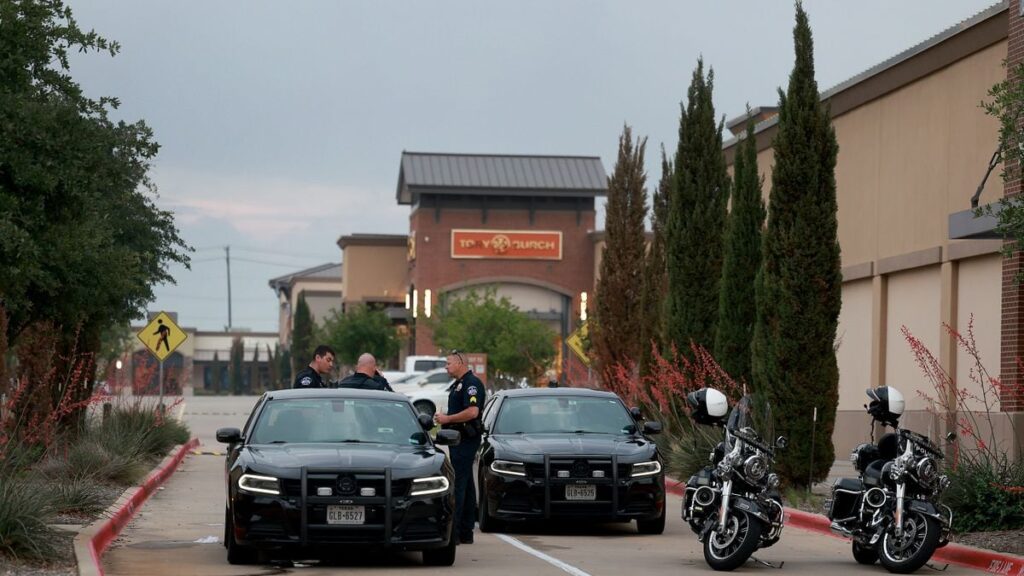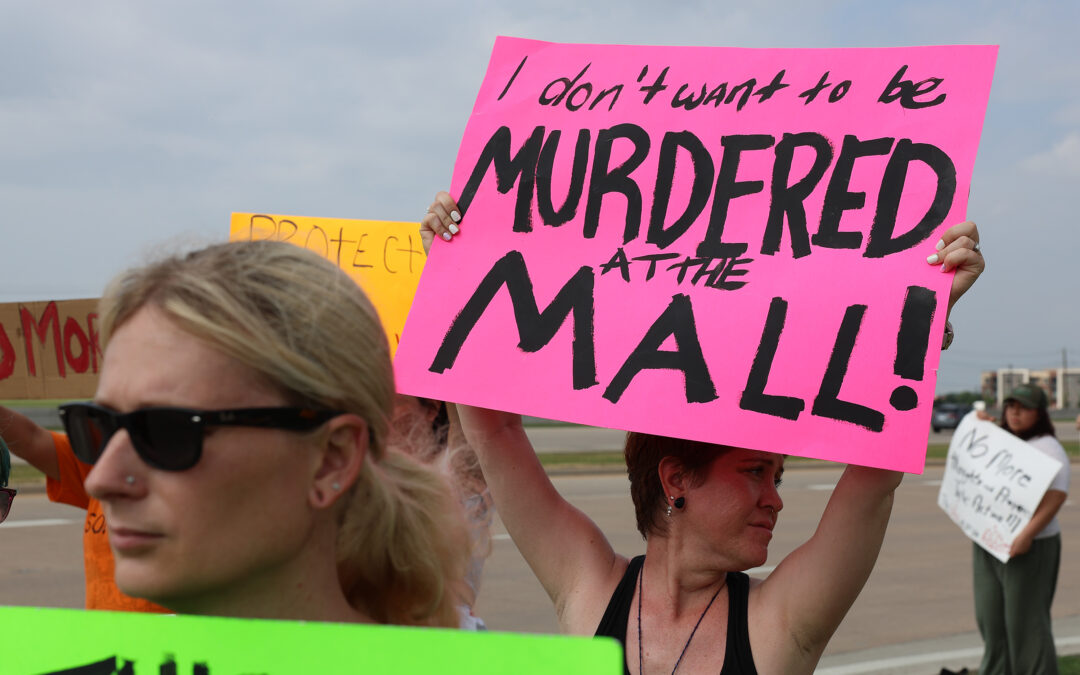Protesters against gun violence outside a church on May 7 in Allen, Texas, a day after a mass shooting at the nearby Allen Premium Outlets mall. Joe Raedle / Staff via Getty Images
Stores and malls are especially vulnerable to random attacks like the recent killing of eight people at the Allen Premium Outlets in Texas.
On Thursday, five days after a gunman with a semi-automatic rifle and other weapons opened fire and killed eight people, the Allen Premium Outlets near Dallas remains closed until further notice. The Simon Property Group-owned mall has been turned into a place of memorial and mourning. Three children died; the youngest homicide victim was three years old, the oldest 37, according to the Allen, Texas, police department.
“As a proud member of the Allen community, we continue to grieve for the eight innocent lives lost, their families, those who were injured, and all who are struggling in the face of this tragedy,” reads a black banner on the mall’s website. “As we move forward, the needs of our retailers and our community will guide when and how we reopen the center.”
It was yet another bloody episode at a retail venue that sent shoppers and store employees panicking and left behind casualties and destruction, including numerous fatalities. Gun violence in general is happening more often at stores and shopping centers. When it comes to mass shootings in public like the one in Texas last week, the location itself is the target, experts say.

Police on May 8 block an entrance to the Allen Premium Outlets, two days after a shooter opened fire at the Texas mall, killing eight. Joe Raedle / Staff via Getty Images
It was yet another bloody episode at a retail venue that sent shoppers and store employees panicking and left behind casualties and destruction, including numerous fatalities. Gun violence in general is happening more often at stores and shopping centers. When it comes to mass shootings in public like the one in Texas last week, the location itself is the target, experts say.
The target
A mass public shooting is defined by the U.S. Congress as a single incident where four or more victims are murdered with firearms, not including the shooter, in a public location, unconnected to underlying criminal activity or any personal connection or argument.
Retail venues have endured them in every decade of the past 60 years or so, though more than half occurred in the last 15 years, according to the Violence Project, which gathers a variety of statistics on the issue.
In Allen, there were red flags about the gunman, including “neo-Nazi ideation” and the fact that the U.S. Army let him go after basic training, Texas Department of Public Safety Regional Director Hank Sibley told reporters on Tuesday. He obtained his eight weapons legally, had no criminal history and once had a security guard license.
“To me, it looks like he targeted the location rather than a specific group of people,” Sibley said. “He was very random in the people he killed, it didn’t matter the age, race or sex. He just shot people, which is horrific in itself.”
Stores and malls are increasingly the scene of mass shootings.
Number of mass public shootings in the U.S. so far, by location, 1966-2022
The frequency of these incidents is accelerating, according to Michael Lawlor, a criminal justice professor at the University of New Haven. “By and large, these happen in places where people gather — maybe a hospital, a church, a school, a shopping mall, a bank,” he said by phone.
In a report on security released in September, the National Retail Federation noted that “mass violence/active assailants” is a growing concern of 57.9% of its members, gun violence is a growing concern for 52.6%, and guest-on-associate violence is a growing concern for 77.6%.
“The current climate of active assailants and gun violence add to retailers’ concerns about being able to keep employees and customers safe,” the NRF said in the report.
Response
So far, the industry has focused on how to prepare for and respond to such situations, rather than prevent them. It does behoove mall owners to have a well trained security guard or police officer on site, according to Lawlor.

“A good general rule is, you want your staff, especially your security guards, to be trained in recognizing the signs — what we refer to as red flags — and know what options they have available if they see stuff that creates a concern in their mind,” he said. “The shooting in Texas was interrupted by an on-duty police officer who just happened to be in the mall. So it’s worth considering having an extra-duty police officer around just in case something does happen. It’s not going to prevent it from happening in the first place. But if it does happen there’s at least one person there who could deal with it.”
An NRF spokesperson said it works with law enforcement agencies to educate members and staff on matters like deadly shootings. A spokesperson for the Retail Industry Leaders Association noted by email that retailers conduct regular active-shooter training exercises. “When a horrific event happens, retailers’ first priority is to support the affected community, employees, and law enforcement,” the RILA spokesperson said.
Follow Daphne Howland on Twitter
For more retail related news and resources, be sure to bookmark the following link: https://www.retaildive.com/
If you are not yet a BRA Retail Member, you can easily opt in to either Regular (no cost) or Distinguished ($100/yr.) Membership via this super simple join form

